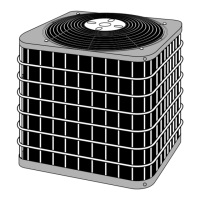INSPECT EQUIPMENT
File claim with shipping company prior to installation if shipment
is damaged or incomplete. Locate unit rating plate on unit corner
panel. It contains information needed to properly install unit.
Check rating plate to be sure unit matches job specifications.
Step 2—Install on a Solid, Level Mounting Pad
If conditions or local codes require the unit be attached to pad, tie
down bolts should be used and fastened through knockouts
provided in unit base pan. Refer to unit mounting pattern in Fig. 3
to determine base pan size and knockout hole location.
On rooftop applications, mount on level platform or frame. Place
unit above a load-bearing wall and isolate unit and tubing set from
structure. Arrange supporting members to adequately support unit
and minimize transmission of vibration to building. Consult local
codes governing rooftop applications.
Roof mounted units exposed to winds above 5 mph may require
wind baffles. Consult Low-Ambient Guideline for wind baffle
construction.
NOTE: Unit must be level to within ± 2° (± 3/8 in./ft) per
compressor manufacturer specifications.
Step 3—Clearance Requirements
When installing, allow sufficient space for airflow clearance,
wiring, refrigerant piping, and service. Allow 30-in. clearance to
service end of unit and 48 in. above unit. For proper airflow, a 6-in.
clearance on 1 side of unit and 12 in. on all remaining sides must
be maintained. Maintain a distance of 24 in. between units.
Position so water, snow, or ice from roof or eaves cannot fall
directly on unit.
On rooftop applications, locate unit at least 6 in. above roof
surface.
Step 4—Operating Ambients
The minimum outdoor operating ambient in cooling mode is 55°F,
and the maximum outdoor operating ambient in cooling mode is
125°F.
Step 5—Check Indoor AccuRater® Piston
Check indoor coil piston to see if it matches the required piston
shown on outdoor unit rating plate. If it does not match, replace
indoor coil piston with piston shipped with outdoor unit. The
piston shipped with outdoor unit is correct for any approved indoor
coil combination.
Remove indoor coil piston if unit is to be installed on system
with a TXV metering device.
Step 6—Make Piping Connections
Relieve pressure and recover all refrigerant before system
repair or final unit disposal to avoid personal injury or death.
Use all service ports and open all flow-control devices,
including solenoid valves.
If ANY refrigerant tubing is buried, provide a 6 in. vertical
rise at service valve. Refrigerant tubing lengths up to 36 in.
may be buried without further special consideration. For
lengths above 36 in., refer to Residential Split System
Buried-Line Application Guideline.
Fig. 2—Connecting Tubing Installation
A94028
INSULATION
VAPOR TUBE
LIQUID TUBE
OUTDOOR WALL INDOOR WALL
LIQUID TUBE
VAPOR TUBE
INSULATION
CAULK
Avoid contact between tubing and structureNOTE:
THROUGH THE WALL
HANGER STRAP
(AROUND VAPOR
TUBE ONLY)
JOIST
1″ MIN.
SUSPENSION
Fig. 3—Mounting Unit to Pad
Dimensions (In.)
UNIT
SIZE
MINIMUM
MOUNTING PAD
DIMENSIONS
TIEDOWN KNOCKOUT LOCATIONS
ABC
018, 024 18 X 18 3 15 10-3/16
030–042 22-1/2 X 22-1/2 3-11/16 18-1/8 14-3/8
048, 060 30 X 30 6-1/2 23-1/2 20
A94199
C
B
A
3
⁄
8
″D. (9.53) TIEDOWN
KNOCKOUTS (2) PLACES
2
→
→
→

